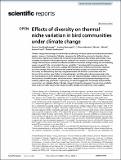Files in this item
Effects of diversity on thermal niche variation in bird communities under climate change
Item metadata
| dc.contributor.author | Marjakangas, Emma Liina | |
| dc.contributor.author | Santangeli, Andrea | |
| dc.contributor.author | Johnston, Alison | |
| dc.contributor.author | Michel, Nicole L. | |
| dc.contributor.author | Princé, Karine | |
| dc.contributor.author | Lehikoinen, Aleksi | |
| dc.date.accessioned | 2023-01-16T17:30:10Z | |
| dc.date.available | 2023-01-16T17:30:10Z | |
| dc.date.issued | 2022-12-17 | |
| dc.identifier | 282921241 | |
| dc.identifier | 2420e7a4-3f2c-4c57-8a4b-9f8ae2af0280 | |
| dc.identifier | 85144170685 | |
| dc.identifier | 36528749 | |
| dc.identifier.citation | Marjakangas , E L , Santangeli , A , Johnston , A , Michel , N L , Princé , K & Lehikoinen , A 2022 , ' Effects of diversity on thermal niche variation in bird communities under climate change ' , Scientific Reports , vol. 12 , 21810 . https://doi.org/10.1038/s41598-022-26248-1 | en |
| dc.identifier.issn | 2045-2322 | |
| dc.identifier.other | ORCID: /0000-0001-8221-013X/work/126554478 | |
| dc.identifier.uri | https://hdl.handle.net/10023/26759 | |
| dc.description | Funding: A.L., A.S. and E.M. were funded by the Academy of Finland (Projects 275606, 307909 and 323527). In addition, the research has been funded through the 2017–2018 Belmont Forum and BiodivERsA joint call for research proposals, under the BiodivScen ERA-Net COFUND programme, and with the funding organisations Academy of Finland (Helsinki: 326338) and the National Science Foundation (CLO, ICER-1927646). Open access funded by Helsinki University Library. | en |
| dc.description.abstract | Climate change alters ecological communities by affecting individual species and interactions between species. However, the impacts of climate change may be buffered by community diversity: diverse communities may be more resistant to climate-driven perturbations than simple communities. Here, we assess how diversity influences long-term thermal niche variation in communities under climate change. We use 50-year continental-scale data on bird communities during breeding and non-breeding seasons to quantify the communities’ thermal variability. Thermal variability is measured as the temporal change in the community’s average thermal niche and it indicates community’s response to climate change. Then, we study how the thermal variability varies as a function of taxonomic, functional, and evolutionary diversity using linear models. We find that communities with low thermal niche variation have higher functional diversity, with this pattern being measurable in the non-breeding but not in the breeding season. Given the expected increase in seasonal variation in the future climate, the differences in bird communities’ thermal variability between breeding and non-breeding seasons may grow wider. Importantly, our results suggest that functionally diverse wildlife communities can mitigate effects of climate change by hindering changes in thermal niche variability, which underscores the importance of addressing the climate and biodiversity crises together. | |
| dc.format.extent | 11 | |
| dc.format.extent | 1633306 | |
| dc.language.iso | eng | |
| dc.relation.ispartof | Scientific Reports | en |
| dc.subject | QH Natural history | en |
| dc.subject | General | en |
| dc.subject | NDAS | en |
| dc.subject | SDG 13 - Climate Action | en |
| dc.subject | MCC | en |
| dc.subject.lcc | QH | en |
| dc.title | Effects of diversity on thermal niche variation in bird communities under climate change | en |
| dc.type | Journal article | en |
| dc.contributor.institution | University of St Andrews. Statistics | en |
| dc.contributor.institution | University of St Andrews. Centre for Research into Ecological & Environmental Modelling | en |
| dc.identifier.doi | https://doi.org/10.1038/s41598-022-26248-1 | |
| dc.description.status | Peer reviewed | en |
This item appears in the following Collection(s)
Items in the St Andrews Research Repository are protected by copyright, with all rights reserved, unless otherwise indicated.

